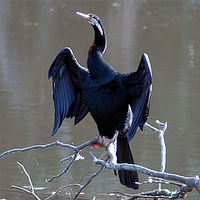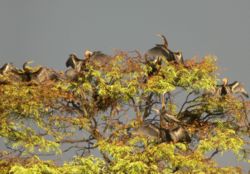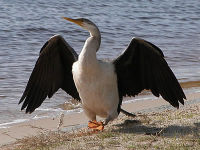|
Darters |

Male
Oriental Darter
|
|
Scientific classification |
| Kingdom: |
Animalia
|
| Phylum: |
Chordata
|
| Class: |
Aves
|
| Order: |
Pelecaniformes
|
| Family: |
Anhingidae
Reichenbach, 1849 |
| Genus: |
Anhinga
Brisson, 1760 |
|
| Species |
A. anhinga
A. melanogaster
A. rufa
A. novaehollandiae
For extinct taxa, see article text. |
The darters or snake-birds are
birds in the family Anhingidae. There are four
living species, one of which is near-threatened. The darters
are frequently referred to as “snake-birds” because of their
long thin neck, which gives a snake-like appearance when
they swim with their bodies submerged.
The darters are large birds with dimorphic plumage. The
males have black and dark brown plumage, an erectile crest
on the nape and a larger bill than the female. The females
have a much paler plumage especially on the neck and
underparts. Both have grey stippling on long scapulars and
upper wing coverts. The sharply pointed bill has serrated
edges. The darters have completely webbed feet, and their
legs are short and set far back on the body. Their plumage
is somewhat permeable, like that of
cormorants, and they spread their wings to dry after
diving. Vocalizations include a clicking or rattling when
flying or perching. During breeding adults sometimes have
caw or hissing calls.
Range:
Darters are circum-equatorial, tropical or subtropical.
They inhabit either fresh or brackish water and can be found
in lakes, rivers, marshes, swamps, estuaries, bays, lagoons
and
mangrove swamps. They tend to gather in flocks sometimes
up to about 100 birds but are highly territorial when
breeding. Most are sedentary and do not
migrate, however the populations at extreme
distributions may migrate. The Oriental Darter is
near-threatened species[1].
Habitat destruction along with other human interferences is
among the main reasons for a declining population.
Diet:
Darters feed mainly on fish. They use their sharply
pointed bill to spear their prey when they dive; this is how
they get the name darter. Their ventral keel is present on
the 5-7 vertebrae which allows for muscles to attach so that
they are able to project their bill forward like a spear.
They also eat amphibians such as frogs and newts, reptiles
such as snakes and turtles and invertebrates such as
insects, shrimp and mollusks. These birds use their feet to
move underwater and quietly stalk and ambush their prey.
They then stab the prey, such as a fish, and bring them to
the surface where they toss it into the air and catch and
swallow it.

Snake birds nesting at Kalletumkara,
Kerala
Breeding:
The darters are monogamous and pair bond during the
breeding season. There are many different types of displays
used for mating including male displays to attract the
female, greeting displays between the male and female and
pair bonding displays between the pairs. Also during
breeding, their small gular sac changes from pink or yellow
to black and the bare facial skin turns to turquoise from a
yellow or yellow-green color. They usually breed in
colonies.
Breeding can be seasonal or year round and varies by
geographic range. The nests are made of twigs and are built
in trees or reeds, often near water. The clutch size is two
to six eggs (usually about 4) of a pale green color and the
eggs are incubated for 25 to 30 days. The eggs hatch
asynchronously.
Bi-parental care is given and the young are considered
altricial. They reach sexual maturity by about 2 years.
These birds generally live to around 9 years.
Systematics and evolution
This family is very closely related to the other families
in the order Pelecaniformes. There are four living species
recognized, all in the
genus Anhinga, although the Old World ones are
often lumped together as subspecies of A. melanogaster.

Female Oriental Darter
- Anhinga, Anhinga anhinga
Oriental Darter, Anhinga melanogaster
African Darter, Anhinga rufa
Australian Darter, Anhinga novaehollandiae
Extinct "species" from Mauritius and Australia known only
from bones were described as Anhinga nana ("Mauritian
Darter") and Anhinga parva, but they were misidentifications
of bones of the Long-tailed Cormorant and the Little Pied
Cormorant, respectively (Miller, 1966;
Olson, 1975). In the former case, however, they might belong
to an extinct subspecies which would have to be called
Phalacrocorax africanus nanus (Mauritian Cormorant) -
quite ironically, as nana means "dwarf" and the
remains are larger than those of the geographically
closest population of the Long-tailed Cormorant.
The darters are known since the Early
Miocene. The diversity was highest in the Americas; a number
of prehistoric species and
genera known only from
fossils have been described. The aptly named
Macranhinga, Meganhinga and Giganhinga
represent very large and flightless forms.
- Meganhinga (Early Miocene of Chile)
- Macranhinga (Late Miocene -? Early Pliocene
of SC South America)
- Giganhinga (Late Pliocene/Early Pleistocene
of Uruguay)
- Anhinga subvolans (Early Miocene of Thomas
Farm, USA)
- Anhinga cf. grandis (Middle Miocene of
Colombia -? Late Pliocene of SC South America)
- Anhinga fraileyi (Late Miocene -? Early
Pliocene of S South America)
- Anhinga minuta (Solimões Late Miocene/Early
Pliocene of SC South America)
- Anhinga pannonica (Late Miocene/Early
Pliocene of Tataruş-Brusturi, Hungary ?and Tunisia,
Pakistan and Thailand)
- Anhinga grandis (Late Miocene - Kimball Late
Pliocene of USA)
- Anhinga malagurala (Allingham Early Pliocene
of Charters Towers, Australia)
- Anhinga cf. pannonica (Sahabi Early
Pliocene of Libya)
- Anhinga sp. (Early Pliocene of Bone Valley,
USA)
- Anhinga hadarensis (Late Pliocene/Early
Pleistocene of E Africa)
- Anhinga sp. (Early Pleistocene of Coleman,
USA)
References
- Answers.com (2003):
darter. In: Columbia Electronic Encyclopedia,
Sixth Edition Columbia University Press. Accessed
August 29, 2006.
- Georgia Museum of Natural History &
Georgia Department of Natural Resources (2000):
Order: Pelicaniformes. In: Georgia Wildlife Web.
Accessed August 30, 2006.
- Lockwood, Burleigh (2006):
Pelecaniformes. Fresno Chaffee Zoo. Accessed
August 30, 2006.
- Miller, Alden H. (1966): An Evaluation of the
Fossil Anhingas of Australia.
Condor 68(4): 315-320.
PDF fulltext
- Myers, P.; Espinosa, R.; Parr, C. S.; Jones,
T.; Hammond, G. S. & Dewey, T. A. (2006):
Anhingidae. In: The Animal Diversity Web (online).
Accessed August 29, 2006.
- Olson, Storrs L. (1975): An Evaluation of the
Supposed Anhinga of Mauritius.
Auk 92:374-376.
PDF fulltext
External links




